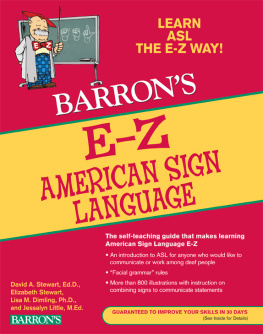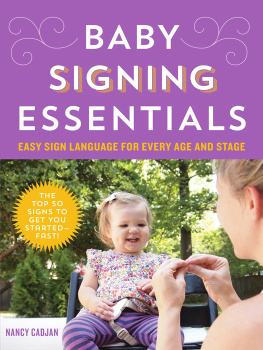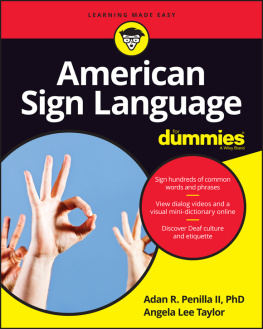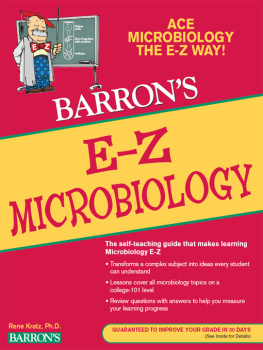
Dedicated to the memory of my brilliant husbandauthor
of this bookinspiring his family, friends, and students to
continue his work. Liz
Dedicated to Joe, Emmett, Elliott and Elise  Beth
Beth
Acknowledgments
Many thanks to my colleagues and the many ASL students who provided feedback on the content and flow of the text. A special thanks to the following people who helped review the manuscript and put it together: Brenda Cartwright, Lynn Duckwall, Judy Foren, Tanna Girod, Kelly Grondin, Michael Kellett, and Liz.
This excerpt is reprinted by permission of the publisher, The Study of Language, George Yule, Press Syndicate of the University of Cambridge University Press, 1985.
This excerpt is reprinted by permission of the publisher, The Mask of Benevolence, Harlan Lane, DawnSignPress, 1992.
This excerpt is reprinted by permission of the publisher, from C.A. Padden, The Relation Between Space and Grammar in ASL Verb Morphology in Sign Language Research: Theoretical Issues, Ceil Lucas, ed. (1990): 18, Washington, D.C.: Gaullaudet University Press. Copyright 1990 by Gallaudet University.
This excerpt is reproduced with permission of DawnSignPress.
This excerpt is from Deaf in America: Voices from a Culture, by Carol Padden and Tom Humphries. Copyright 1988 by the President and Fellows of Harvard College. Reprinted by permission of Harvard University Press.
This excerpt is reprinted with permission of the publisher, for Dennis Cokely and Charlotte Baker, eds., American Sign Language: A Teachers Resource Text on Grammar and Culture (1980), Washington, D.C.: Galluadet University Press. Copyright 1980 by Dennis Cokely and Charlotte Baker.
This excerpt is reprinted from Meeting Halfway in American Sign Language (1993). Copyright 1993 Deaf Life Press. Used with permission.
How We Are (also appearing ) is reprinted with permission of the publisher, from J. D. Schein, At Home Among Strangers (1989): 40, 68. Washington, D.C.: Gallaudet University Press. Copyright 1989 by Gallaudet University.
Language for the Eye by Dorothy Miles (): Viewpoint on Deafness, A Deaf American Monograph. Copyright 1992. Donald Eastwood Read, Executor, granted permission.
On His Deafness (): from Communication Issues Among Deaf People: Deaf American Monograph, by Robert F. Panara. Copyright 1990.
Words From a Deaf Child (): Communication Issues Among Deaf People, A Deaf American Monograph. Copyright 1990.
My Clipped Wings (.
Every effort has been made to contact the copyright holders. Barrons Educational Series and the author apologize for any unintentional omissions. We would be pleased to insert the appropriate acknowledgment in future editions of this book.
Copyright 2011, 2007, 1998 Barrons Educational Series, Inc
All rights reserved. No part of this work may be reproduced in any form or by any means without the written permission of the copyright owner.
All inquiries should be addressed to:
Barrons Educational Series, Inc.
250 Wireless Boulevard
Hauppauge, New York 11788
http://www.barronseduc.com
ISBN: 978-0-7641-4458-5
eISBN: 978-0-7641-4380-8294-3
Library of Congress Catalog Card No. 2010041277
Library of Congress Cataloging-in-Publication Data
E-Z American Sign Language / David A. Stewart [et al.] ; illustrated by Beth Roberge Friedrichs. 3rd ed.
p. cm. (E-Z)
Rev. ed. of: American Sign Language the easy way /David A. Stewart, Elizabeth Stewart, Jessalyn Little. 2nd ed. c2007.
1. American Sign Language. I. Stewart, David Alan, 1954II. Stewart, David Alan, 1954American Sign Language the easy way.
HV2474.S67 2011
419'.7--dc22 2010041277
CONTENTS
Chapter 1:
Chapter 2:
Lesson 1
Lesson 2
Lesson 3
Lesson 4
Lesson 5
Lesson 6
Lesson 7
Chapter 3:
Chapter 4:
Chapter 5:
Lesson 8
Lesson 9
Lesson 10
Lesson 11
Chapter 6:
Lesson 12
Lesson 13
Lesson 14
Chapter 7:
Technology and Other Adaptations:
Chapter 8:
Lesson 15
Lesson 16
Lesson 17
Chapter 9:
Chapter 10:
Lesson 18
Lesson 19
Lesson 20
Review of Lessons 1520
Chapter 11:
Lesson 21
Lesson 22
Lesson 23
Lesson 24
Lesson 25
Lesson 26
Chapter 12:
Chapter 13:
Lesson 27
Lesson 28
Lesson 29
Lesson 30
Lesson 31
Lesson 32
Lesson 33
Chapter 14:
Chapter 15:
Lesson 34
Lesson 35
Lesson 36

E-Z American Sign Language is designed to make you a better signer. Here are some suggestions for using this book:
Think visually. American Sign Language (ASL) is understood by seeing it because all information in ASL is visual. How you make a sign is important, but just as important are the facial expressions and body movements you use when signing. Read about the facial grammar of ASL in to help you make the transfer from a communication based on sounds to one thats entirely based on seeing.
Learn the ten basic ASL grammar rules. Examples of how these rules are used in a dialogue are given in the 36 lessons that follow. Most of the rules are frequently repeated to help you gain greater familiarity with them.
Study the chapters that focus on a particular aspect of ASL such as directional verbs (). These chapters will give you a better understanding of the spatial qualities of ASL.
Master signing the dialogues. Each lesson has a dialogue, and they become progressively more difficult throughout the book. Practice signing each dialogue until you are comfortable with the signing. You can do this best with a partner or a fluent ASL signer, but if you are alone, practice signing in front of a mirror or videotape yourself. This practice will help you develop fluency in your signing. The dialogues are broken up in the sections called Practice Activities. Practicing the shorter pieces of the dialogues will help you gain greater fluency when practicing the entire dialogue.
Learn to analyze ASL language structures and signs. Each dialogue is analyzed in a section called Whats in the Signs (Notes about the Grammar). Read this section carefully so that you get a feel for how ASL is structured. Some signs are discussed separately in a section called Whats in a Sign (Notes about Vocabulary). Read this section to learn about the reasons some signs are produced in a certain way.
Follow all suggestions for further practice that require you to develop your own dialogues and practice signing them.
Create ASL sentences and write the English translations of these sentences. Translation is important for learning the differences between ASL and English grammar because in ASL you do not sign each word you say in English and the ASL grammar is different from English grammar.
Learn the different meanings of some ASL signs. A listing of these signs and their alternative meanings is presented in most chapters.
Learn about Deaf culture. Five chapters introduce you to different aspects of Deaf culture.
Mastering ASL will require more than just mastering the dialogues and ASL rules presented in this book. Communicating with Deaf people will help you learn more about ASL and help you expand your vocabulary of signs.
Next page








 Beth
Beth